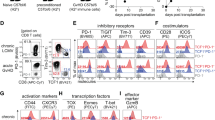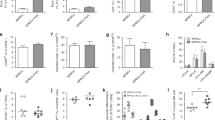Summary:
The pathogenesis of acute graft-versus-host disease (aGVHD) includes tumor necrosis factor-alpha (TNFα) expression by macrophages and T cells. However, the temporal comparison of donor vs host cells to TNFα expression in response to irradiation conditioning and alloreactivity has not been reported. This study compared intracellular TNFα expression in donor vs host spleen T cells and macrophages using a murine model of aGVHD. Total body irradiation conditioning alone resulted in increased frequency of F4/80+/TNFα+ cells, but no increase in CD3+/TNFα+ cells. Syngeneic transplantation resulted in an increased frequency of F4/80+/TNFα+ cells, while CD3+/TNFα+ cells increased on days 1 and 3 but declined on day 5. Allogeneic transplantation resulted in an increased frequency of donor CD3+/TNFα+ cells, while the frequency of host CD3+/TNFα+ cells declined. Similarly, donor F4/80+/TNFα+ cells also increased in frequency after allotransplantation, while the frequency of host F4/80+/TNFα+ cells was increased on day 1 and declined through days 3 and 5. In absolute cell numbers, CD3+/TNFα+ cells were greater than F4/80+/TNFα+ cells post allotransplantation. We conclude that (1) both donor and host CD3+ and F4/80+cells are present in the post transplant period and contribute to TNFα production and (2) in terms of frequency, the majority of TNFα producing cells in the spleen after allogeneic BMT are CD3+.
This is a preview of subscription content, access via your institution
Access options
Subscribe to this journal
Receive 12 print issues and online access
$259.00 per year
only $21.58 per issue
Buy this article
- Purchase on Springer Link
- Instant access to full article PDF
Prices may be subject to local taxes which are calculated during checkout





Similar content being viewed by others
References
Antin JH, Ferrara JLM . Cytokine dysregulation and acute graft-versus-host disease. Blood 1992; 80: 2964–2968.
Nagler A, Bishara A, Brautbar C, Barak V . Dysregulation of inflammatory cytokines in unrelated bone marrow transplantation. Cytokines Cell Mol Ther 1998; 4: 161–167.
Piquet PF, Grau GE, Allet B, Vassalli PJ . Tumor necrosis factor/cachectin is an effector of skin and gut lesions of the acute phase of graft-versus-host disease. J Exp Med 1987; 166: 1280–1289.
Racadot E, Milpied N, Bordigoni P et al. Sequential use of three monoclonal antibodies in corticosteroid-resistant acute GVHD: a multicenter pilot study including 15 patients. Bone Marrow Transplant 1995; 15: 669–677.
Herve P, Flesch M, Tiberghien P et al. Phase I–II trial of a monoclonal anti-tumor necrosis factor alpha antibody for the treatment of refractory severe acute graft-versus-host disease. Blood 1992; 79: 3362–3368.
Hattori K, Hirano M, Yamakawa N et al. Differential effects of anti-Fas ligand and anti-tumor necrosis factor antibodies on acute graft-versus-host disease pathologies. Blood 1998; 91: 4051–4055.
Brown GR, Lingberg G, Meddings J et al. Tumor necrosis factor inhibitor ameliorates murine intestinal graft-versus-host disease. Gastroenterology 1999; 116: 593–601.
Ferrara JLM . Cytokine inhibitors and graft-versus-host disease. Ann NY Acad Sciences 1995; 770: 227–236.
Tsukada N, Kobata T, Aizawa Y et al. Graft-versus-leukemia effect and graft-versus-host disease can be differentiated by cytotoxic mechanisms in a murine model of allogeneic bone marrow transplantation. Blood 1999; 93: 2738–2747.
Speis DE, Bachmann MF, Frick TW et al. TNF receptor p55 controls early acute graft-versus-host disease. J Immunol 1997; 158: 5185–5190.
Sherman ML, Datta R, Hallahan DE et al. Regulation of tumor necrosis factor gene expression by ionizing radiation in human myeloid leukemia cells and peripheral blood monocytes. J Clin Invest 1991; 87: 1794–1797.
Nestel FP, Price KS, Seemayer TA, Lapp WS . Macrophage priming and lipopolysaccharide-triggered release of tumor necrosis factor alpha during graft-versus-host disease. J Exp Med 1992; 175: 405–413.
Schmaltz C, Alpdogan O, Muriglan SJ et al. Donor T cell-derived TNF is required for graft-versus-host disease and graft-versus-tumor activity after bone marrow transplantation. Blood 2003; 101: 2440–2445.
Zhou D, Brown SA, Yu T et al. Ionizing irradiation induces tissue-specific activation of nuclear factor-κB in vivo. Radiat Res 1999; 151: 703–709.
Zhou D, Yu T, Chen G et al. Effects of NF-κB1 (p50) targeted gene disruption on ionizing radiation-induced NF-κB activation and TNFα, IL-1a, IL-1B and IL-6 mRNA expression in vivo. Int J Radiat Biol 2001; 77: 763–772.
Baeuerle PA, Hinkel T . Function and activation NF-κB in the immune system. Annu Rev Immunol 1996; 14: 649–681.
Korngold R, Sprent JJ . Lethal graft-versus-host-disease after bone marrow transplantation across minor histocompatibility barriers in mice. Prevention by removing mature T cells from marrow. J Exp Med 1978; 148: 1687–1698.
Ho VT, Soiffer RJ . The history and future of T cell depletion as graft-versus-host disease prophylaxis for allogeneic hematopoietic stem cell transplantation. Blood 2001; 98: 3192–3204.
Shlomchik WD, Couzens MS, Tang CB et al. Prevention of graft versus host disease by inactivation of host antigen-presenting cells. Science 1999; 285: 412–415.
Hill GR, Crawford JM, Cooke KR et al. Total body irradiation and acute graft-versus-host disease: The role of gastrointestinal damage and inflammatory cytokines. Blood 1997; 90: 3204–3213.
Hill GR, Cooke KR, Brinson YS et al. Pretransplant chemotherapy reduces inflammatory cytokine production and acute graft-versus-host disease after allogeneic bone marrow transplantation. Transplantation 1999; 67: 1478–1480.
Truitt RL, Atasoylu AA . Impact of pretransplant conditioning and donor T cells on chimerism, graft-versus-host disease, graft-versus-leukemia reactivity, and tolerance after bone marrow transplantation. Blood 1991; 77: 2515–2523.
Xun CQ, Tsuchida M, Thompson JS . Delaying transplantation after total body irradiation is a simple and effective way to reduce acute graft-versus-host disease mortality after major H2 incompatible transplantation. Transplantation 1997; 64: 297–302.
Iwamoto KS, McBride WH . Production of 13-hydroxyoctadecadienoic acid and tumor necrosis factor-alpha by murine peritoneal macrophages in response to irradiation. Radiat Res 1994; 139: 103–108.
Lucas M, Stuart LM, Savill J, Lacy-Hulbert A . Apoptotic cells and innate immune stimuli combine to regulate macrophage cytokine secretion. J Immunol 2003; 171: 2610–2615.
Weill D, Gay F, Tovy MG, Chouaib S . Induction of tumor necrosis factor alpha expression in human T lymphocytes following ionizing gamma irradiation. J Interferon Cytokine Res 1996; 16: 395–402.
Butturini A, Seeger RC, Gale RP . Recipient immune-competent T lymphocytes can survive intensive conditioning for bone marrow transplantation. Blood 1986; 68: 954–956.
Slordal L, Muench MO, Warren DJ, Moore MA . Radioprotection by murine and human tumor-necrosis factor: dose dependent effects on hematopoiesis in the mouse. Eur J Haematol 1989; 43: 428–434.
Dalmau SR, Freitas CS, Savino W . Radio- and chemoprotection of bone marrow cells by opposite cell cycle-acting cytokines. Leuk Res 1997; 21: 93–99.
Song HK, Noorchashm H, Lieu YK et al. Cutting edge: alloimmune responses against major and minor histocompatibility antigens: distinct division kinetics and requirement for CD28 costimulation. J Immunol 1999; 162: 2467–2471.
Price KS, Nestel FP, Lapp WS . Progressive accumulation of bacterial lipopolysaccharide in vivo during murine acute graft-versus-host disease. Scand J Immunol 1997; 45: 294–300.
Acknowledgements
Supported by a VA Merit Review Entry Program award to SAB, a VA Merit Review Grant to JST, and Grants from the NIH (CA78688 and CA86860) to DZ.
Author information
Authors and Affiliations
Corresponding author
Rights and permissions
About this article
Cite this article
Brown, S., Konopa, J., Zhou, D. et al. Expression of TNFα by CD3+ and F4/80+ cells following irradiation preconditioning and allogeneic spleen cell transplantation. Bone Marrow Transplant 33, 359–365 (2004). https://doi.org/10.1038/sj.bmt.1704362
Received:
Accepted:
Published:
Issue Date:
DOI: https://doi.org/10.1038/sj.bmt.1704362
Keywords
This article is cited by
-
Adoptive immunotherapy for cancer: building on success
Nature Reviews Immunology (2006)



